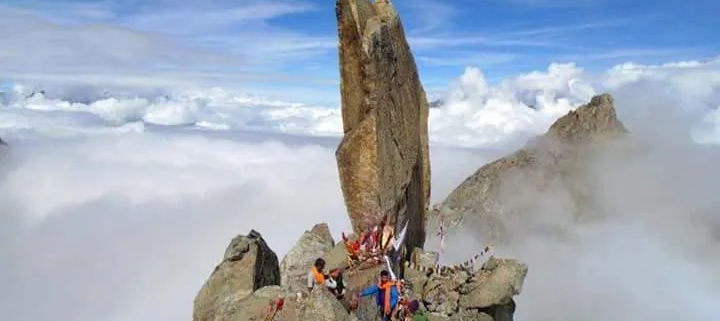Beyond its primary religious significance and trekking allure, Kinnaur Kailash holds a wealth of fascinating details that contribute to its unique character and draw. Let’s explore further aspects of this sacred mountain and its surrounding region:
Geological Significance and Natural Wonders:
- The Shivlingam’s Composition: The towering Shivlingam is primarily composed of a dark greyish-black rock, likely a type of granite or gneiss, common in the Himalayan region. Its smooth, near-vertical face is a testament to the powerful geological forces that shaped this landscape over millennia. The changing colors observed throughout the day are likely due to the angle of sunlight, atmospheric conditions, and the mineral composition of the rock reflecting light differently.
- Glacial Activity: The higher reaches of the Kinnaur Kailash range are adorned with glaciers, though they have been subject to the global trend of glacial retreat. These glaciers feed the streams and rivers that flow through the Kinnaur Valley, playing a vital role in the region’s ecology and water resources.
- Unique Flora and Fauna: The trek to Kinnaur Kailash passes through diverse altitudinal zones, each supporting unique flora and fauna. Lower altitudes are characterized by pine and deodar forests, giving way to birch and rhododendron as elevation increases. Higher up, alpine meadows carpet the landscape with vibrant wildflowers during the summer months. Wildlife in the region includes Himalayan black bears, snow leopards (rarely sighted), musk deer, various species of pheasants, and birds of prey.
- The Sutlej River Connection: The mighty Sutlej River, one of the longest rivers in the Indian subcontinent, flows through the Kinnaur Valley, carving deep gorges and contributing to the dramatic landscape surrounding Kinnaur Kailash. The river holds its own religious significance and is an integral part of the region’s geography.
Cultural and Social Fabric:
- Harmonious Coexistence: Kinnaur is a region where Hinduism and Buddhism have coexisted peacefully for centuries, influencing each other’s traditions and practices. Many local deities are revered by followers of both faiths, and monasteries and temples often stand in close proximity.
- Kinnauri Architecture: The traditional architecture of Kinnaur is distinctive, characterized by multi-storied stone and wood houses with sloping roofs adapted to the heavy snowfall in the region. These structures often feature intricate wood carvings that reflect the local craftsmanship and cultural heritage.
- Local Festivals and Traditions: The Kinnaur region celebrates unique festivals that are deeply rooted in their agricultural cycles and religious beliefs. These festivals often involve vibrant dances, traditional music, and local deities being carried in processions. The Phulaich festival, celebrating the blooming of flowers, and Losar, the Tibetan New Year, are significant events.
- Apple Orchards and Economy: Kinnaur is famous for its high-quality apples, which form a significant part of the local economy. The terraced slopes are often covered with apple orchards, contributing to the region’s scenic beauty and providing livelihoods for many families.
- The Kinnauri Language: The local language, Kinnauri, is a Tibeto-Burman language with various dialects spoken across the region. It reflects the unique cultural identity of the Kinnaur people.

The Trek Experience in Detail:
- Varying Terrain and Challenges: The Kinnaur Kailash trek presents a diverse range of terrains, from relatively gradual climbs through forests to steep ascents over rocky paths and moraines. Altitude sickness is a significant concern, and proper acclimatization is crucial. The unpredictable mountain weather can also pose challenges, with sudden changes in temperature and visibility.
- Spiritual Encounters: For many pilgrims, the trek is not just a physical endeavor but a spiritual journey. The challenging nature of the trek is often seen as a form of penance, and reaching the Shivlingam is considered a deeply fulfilling spiritual experience. The serene environment and the majestic presence of the mountain inspire a sense of awe and reverence.
- The Role of Local Communities: The local communities along the trek routes play a vital role in supporting the pilgrims and trekkers. They provide accommodation, food, and guidance, and their warm hospitality adds to the overall experience. Engaging with the local culture offers a deeper understanding of the region’s traditions and way of life.
- Sustainability and Responsible Tourism: As the popularity of the Kinnaur Kailash trek grows, it’s increasingly important to promote sustainable tourism practices. This includes respecting the local environment and culture, avoiding littering, supporting local businesses responsibly, and minimizing one’s ecological footprint.
Mysteries and Legends:
- Unexplained Phenomena: Some local legends speak of unexplained lights and sounds around the Kinnaur Kailash peak, adding to its mystical aura. While these remain unverified, they contribute to the folklore surrounding the mountain.
- The Untouched Summit: Unlike some other prominent Himalayan peaks, the actual summit of Kinnaur Kailash is generally not attempted by trekkers or pilgrims due to its extreme steepness and perceived sanctity. The focus remains on reaching the Shivlingam and Parvati Kund.
Kinnaur Kailash is a destination that captivates with its spiritual significance, breathtaking natural beauty, and unique cultural heritage. It offers a challenging yet deeply rewarding experience for those who venture into its majestic embrace, leaving an indelible mark on their hearts and souls. The intricate tapestry of mythology, geology, culture, and adventure makes Kinnaur Kailash a truly special and unforgettable place.





Leave a Reply
Want to join the discussion?Feel free to contribute!